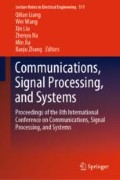Abstract
In order to study the development law of lightning induced overvoltage on transmission lines, based on the theory of lightning electromagnetic field, Taylor’s formula is used to develop the first two expressions of the lightning current double exponential function, and the correction factor is introduced to offset the error of the latter items when the expansion is performed. This expression gives the analytical solution of the vertical electric field. Combined with the field line induction equation of the transmission line, the D’Alembert formula is used to solve the field line induction equation, and the scattered field voltage on the line is solved, and then the induced overvoltage is obtained. The correct parameter value is selected by simulation to verify its correctness.
Access this chapter
Tax calculation will be finalised at checkout
Purchases are for personal use only
References
Liu L, Cui X (2013) research on lightning induction overvoltage calculation and flashover probability of electrified railway contact network. J North China Electr Power Univ 40(2):10–16
Zhang Y, Liu F, Wang Y et al (2013) Improved double-exponential function lightning current waveform and its calculation of radiated electromagnetic field. Trans China Electrotech Soc 28(2):131–139
Yu Z, Zeng W, Wang S et al (2013) Simulation analysis of lightning induction overvoltage of distribution lines. High Voltage Eng 39(2):415–422
Jing H, Wang S (2017) Research on spatial electromagnetic field around lightning strike-back channel based on time domain difference method. Electromagn Arrester (5):65–70
Zhang H (2006) High voltage technology. China Electric Power Press, Beijing, p 127
Rubinstein M, Uman MA (1991) Transient electric and magnetic fields associated with establishing a finite electrostatic dipole, revisited. IEEE Trans EMC 33(4):312–320
Cooray V (1994) Calculation lightning-induced overvoltage in power lines: A comparison of two coupling models. IEEE Trans Electromagn Compat 36(3):179–182
Zhou B, Wang Y, Li L (2005) Mathematical physics equation. Publishing House of Electronics Industry, Beijing, p 223
Zhou Y, Li K (2018) Comparison of lightning arrester and lightning protection of lightning induced overvoltage on overhead lines. Electromagn Lightning Arrester 5:86–90
China Electric Power Research Institute (2014) Design specifications for overvoltage protection and insulation coordination of AC electrical equipment: GB/T50064-2014. China Planning Press, Beijing
Coelho VL, Raizer A, Paulino JOS (2010) Analysis of the lightning performance of overhead distribution lines. IEEE Trans Power Delivery 25(3):1706–1712
Hoidalen HK (2003) Calculation of Lightning-induced volt-ages in models including lossy ground effects. In: International conference on power systems transients (IPST 2003), pp 1–6
Gulyas A, Szedenik N (2009) 3D simulation of the lightning path using a mixed physical-probabilistic model—the open source lightning model. J Electrostat 67(2):518–523
Heidler F, Cvetic JM, Stanic BV (1999) Calculation of lightning current parameters. IEEE Trans Power Delivery 14(2):399–404
Author information
Authors and Affiliations
Corresponding author
Editor information
Editors and Affiliations
Rights and permissions
Copyright information
© 2020 Springer Nature Singapore Pte Ltd.
About this paper
Cite this paper
Qiu, Y., Li, D., Shi, X. (2020). Calculation and Simulation of Inductive Overvoltage of Transmission Line Based on Taylor’s Formula Expansion Double Exponential Function. In: Liang, Q., Wang, W., Liu, X., Na, Z., Jia, M., Zhang, B. (eds) Communications, Signal Processing, and Systems. CSPS 2019. Lecture Notes in Electrical Engineering, vol 571. Springer, Singapore. https://doi.org/10.1007/978-981-13-9409-6_308
Download citation
DOI: https://doi.org/10.1007/978-981-13-9409-6_308
Published:
Publisher Name: Springer, Singapore
Print ISBN: 978-981-13-9408-9
Online ISBN: 978-981-13-9409-6
eBook Packages: EngineeringEngineering (R0)

